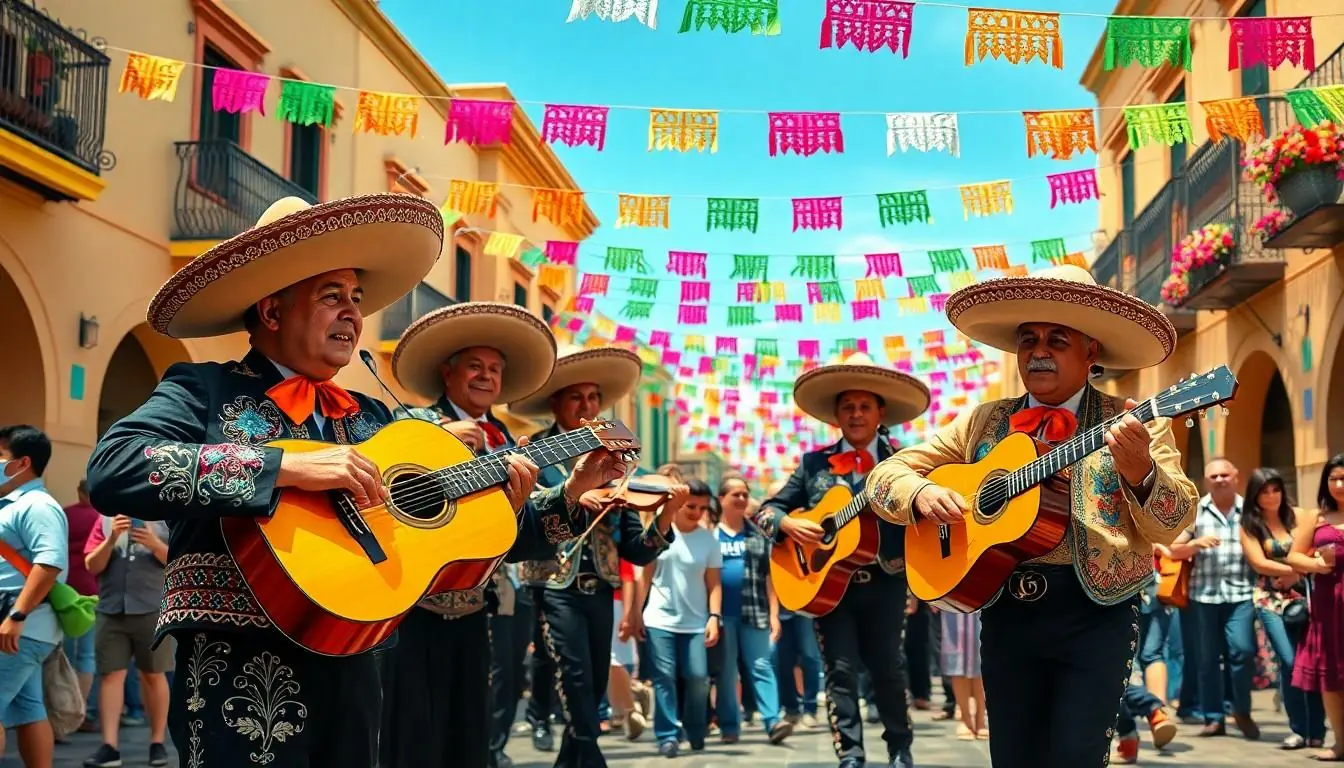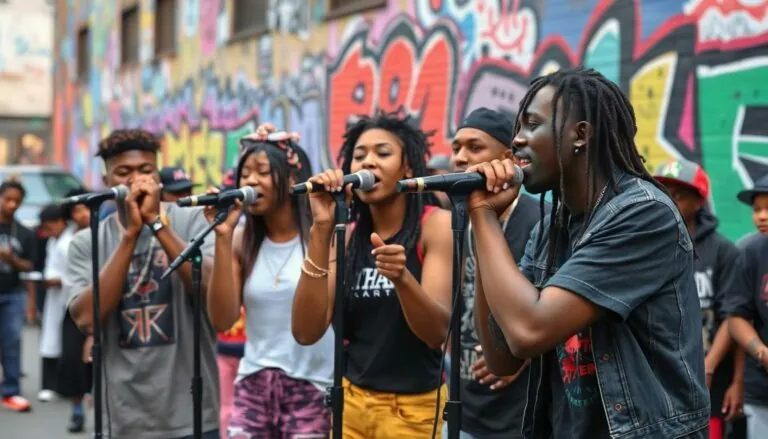Table of Contents
ToggleMexican pop music isn’t just a genre; it’s a vibrant fiesta for the ears. With catchy melodies and infectious rhythms, it’s the soundtrack to countless celebrations and everyday moments. From the sultry sounds of pop ballads to upbeat dance tracks, this genre has something for everyone, whether you’re a seasoned fan or just curious about the latest hits.
Overview of Mexican Pop Music
Mexican pop music captivates audiences with its vibrant rhythms and catchy melodies. This genre includes a variety of styles, blending traditional elements with modern influences. Mariachi, rock, and electronic genres often enrich its diverse sound, creating a unique musical landscape.
Artists like Luis Miguel and Thalía showcase powerful vocals, drawing in fans from various backgrounds. Genres within Mexican pop, such as banda and norteño, contribute to its evolution, incorporating brass and accordion sounds. Tracks might evoke romance through ballads or energize listeners with dance anthems.
The demographic appeal spans generations. Young listeners embrace newer styles, while older fans appreciate nostalgic tunes. Music festivals and concerts serve as gathering places where these audiences unite over shared passions.
Streaming platforms have transformed how Mexican pop music spreads. Accessibility to various artists and songs allows fans to discover new hits easily. Viral hits emerge on social media, often propelling artists to international recognition.
Cultural significance ties deeply into the genre. It reflects contemporary social issues and celebrates Mexican heritage, ensuring it resonates emotionally. Overall, Mexican pop music remains a dynamic part of both personal experiences and wider cultural conversations, thriving within the music industry.
Historical Background

Mexican pop music developed through rich cultural traditions and evolving musical styles. It embodies a blend of indigenous, African, and Spanish influences, creating a unique sound landscape.
Origins and Influences
Folk music forms the backbone of many early Mexican pop styles, especially mariachi and ranchera. Popularity surged during the 20th century as artists began incorporating bolero, cumbia, and rock elements. Movies from the Golden Age of Mexican cinema showcased vibrant soundtracks, promoting stars like Pedro Infante and Jorge Negrete. These iconic performers often fused traditional themes with contemporary melodies, making their music resonate with broader audiences.
Key Genres and Eras
The 1980s marked a significant transformation in Mexican pop music. New wave and rock en español emerged, reflecting global trends while retaining distinct cultural elements. This era also introduced groups like Maná and Los Bukis, who combined romantic themes with innovative sounds. By the 2000s, artists embraced a more international style, integrating electronic music and reggaeton. Presently, genres like banda and trap attract younger fans, highlighting the continuous evolution of the pop landscape in Mexico.
Prominent Mexican Pop Artists
Mexican pop music features a diverse array of talented artists. From legendary icons to fresh new voices, these musicians define the genre.
Iconic Figures
Luis Miguel remains a standout figure in the pop music scene, captivating audiences with his romantic ballads and impressive vocal range. Thalía, known for her dynamic performances, blends pop with traditional sounds to create a unique musical identity. Other influential artists include Alejandra Guzmán and Juanes, whose contributions shaped the genre and continue to inspire new generations. Notable collaborations, such as those between artists and producers, amplify their impact in the music industry.
Emerging Talents
New artists are reshaping the landscape of Mexican pop music today. For instance, the rise of Danna Paola showcases a blend of pop and urban influences. Sofia Reyes and Cazzu also attract attention with their distinct sounds and innovative styles. These artists engage younger audiences through modern themes and fresh production techniques. Streaming platforms play a crucial role in promoting their music, allowing them to reach global fans. Each emerging talent brings unique perspectives that reflect contemporary culture and resonate with listeners.
The Evolution of Mexican Pop Music
Mexican pop music has seen substantial changes over the decades, reflecting cultural shifts and musical experimentation.
Modern Trends and Styles
Contemporary Mexican pop music incorporates diverse styles that appeal to a wide audience. Genres like reggaeton and trap integrate with traditional sounds, creating an engaging listening experience. Artists often blend pop with regional influences, such as mariachi and banda, showcasing this rich musical heritage. Popular figures like Cazzu and Danna Paola exemplify this trend, crafting hits that resonate with both young and older generations. Influences from global music trends further enrich the genre. Emerging artists continue to push boundaries, making the Mexican pop landscape vibrant and dynamic.
Integration of Technology
Technology plays a pivotal role in reshaping Mexican pop music. Streaming platforms make music readily accessible, transforming how fans discover their favorite artists and tracks. Viral challenges on social media allow songs to reach international audiences quickly. Digital tools empower artists to produce high-quality recordings with ease, enhancing their artistic expression. Collaboration across borders has become increasingly common, resulting in unique fusions that reflect global trends. This integration not only amplifies the genre’s reach but also resonates with the evolving preferences of contemporary listeners.
Cultural Impact of Mexican Pop Music
Mexican pop music significantly influences culture, intertwining with social themes and global trends.
Social Issues and Representations
Songs often tackle themes like immigration, identity, and social justice, resonating with a diverse audience. Artists like Residente and Natalia Lafourcade address these topics, shining a light on important societal concerns. Through powerful lyrics and emotive performances, they highlight everyday struggles and aspirations. Collaborations with socially conscious figures enrich the narrative, facilitating deeper discussions about shared experiences. Listeners connect on a personal level, cultivating a sense of community and empathy. Furthermore, Mexican pop music frequently celebrates cultural heritage, fostering pride among fans while encouraging conversations about national identity.
Global Reach and Collaborations
The genre’s global appeal continues to grow, transcending borders and demographics. Collaborations with international artists enhance its reach, introducing Mexican pop sounds to new audiences. Notable partnerships include tracks with global stars like J Balvin and Shawn Mendes, showcasing the fusion of styles and broadening listener bases. Streaming services play a critical role in distributing these collaborations, making music more accessible. Festivals and concerts increasingly feature diverse talent, further highlighting the genre’s intertwining with worldwide trends. Consequently, Mexican pop music remains vibrant, reflecting its strength as a cultural ambassador on the global stage.
Mexican pop music stands as a vibrant reflection of cultural diversity and social dynamics. Its ability to blend traditional and modern influences captivates audiences across generations. As artists continue to innovate and experiment with new sounds, the genre remains relevant and engaging.
The rise of streaming platforms has further amplified its reach, allowing fans to connect with both iconic legends and emerging talents. With its rich history and ongoing evolution, Mexican pop music not only entertains but also sparks important conversations about identity and social issues. This dynamic genre will undoubtedly continue to thrive, resonating with listeners around the world.






